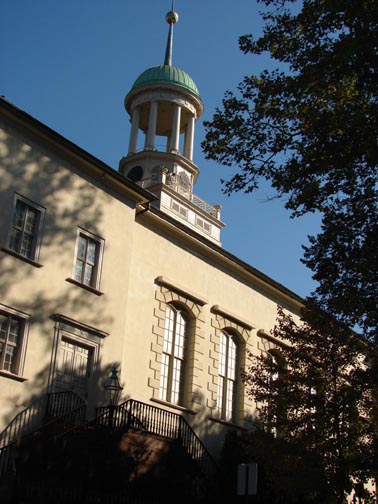
The
History of Central Moravian Church
Weaving through the venerable history
of the Central Moravian Church are the
themes of change, adaptability and
progress. From 1742 when a handful of
Moravian pioneers settled Bethlehem,
Central Church and the early community
emerged simultaneously and forged a
unique bond that has become the
cornerstone of contemporary Moravian
life.
Our story has many parts: Early
Settlement 1742-1800, Building a New
Sanctuary 1803-1806, An Expanding
Community, Bethlehem Area Moravians,
Contemporary Issues and the Church, and
our recent Anniversary celebrations of
the church sanctuary.
EARLY
SETTLEMENT: 1742-1800
In January 1742, the central place of
worship was the Saal, located on the
second floor of the Gemeinhaus or
community house. In June of that year,
fifty-six members comprising the first
Sea congregation arrived in Bethlehem
from Germany and joined the twenty-six
inhabitants already present. The
settlement congregation was officially
organized on June 25, 1742.
In 1751, when the Saal could no longer
accommodate the growing community, the
Old Chapel became the new place of
worship and served the congregation for
the next 55 years.
Concerned that the Old Chapel was not
large enough, members began to press for
a larger church building. None of these
discussions was brought to fruition until
the arrival of Bishop John Ettwein, whose
unwavering determination kept the matter
continually before the membership.
As the result of the General Synod of
1789 in Herrnhut, Germany, Bishop Ettwein
was inspired by the official approval to
build a larger church, but he died before
the decision to build was reached.
BUILDING A NEW
SANCTUARY: 1803-1806
At a Church Council held in September
1802, the vote was made to move ahead
with the building of a new church ; but
disagreement about the construction site
soon developed. Eventually, a compromise
was reached and the present site was
selected. Two log buildings were cleared,
and stone was quarried that winter. Less
than one month later, the massive,
six-feet thick foundation walls were in
place. On April 16, 1803, the cornerstone
was placed at the northwest corner of the
building. The completed building was the
largest church building in Pennsylvania
at that time. But the final cost of
$52,000 had exceeded the $11,000
estimated when the plans were approved.
AN EXPANDING COMMUNITY
In 1845, after the communal system had
been dissolved, the Moravian Church
became incorporated on April 3, 1851.
After other Moravian churches appeared,
the Moravian Congregation of Bethlehem
was formalized in 1905 under a collegiate
system and remained in effect until 1993.
During these 88 years, the members of
West Side, College Hill, and Central
Churches came together to celebrate
various services. Edgeboro Moravian
Church was part of the system until 1942.
BETHLEHEM AREA
MORAVIANS:
6 CONGREGATIONS
In 1992, the 250th anniversary of the
Moravian Church provided the opportunity
for the Moravian Congregation of
Bethlehem to reconstitute its existing
structure. In 1993, all of the Moravian
Churches in Bethlehem formally agreed to
become part of a new organization known
as the Bethlehem Area Moravians (BAM). Advent,
East
Hills, and Edgeboro
churches joined with Central, College
Hill and West
Side for this expanded ministry. We
are fortunate to have such varied
Moravian churches here in Bethlehem.
Together the BAM churches join together
in ministry and outreach to our
congregations and community in such
ventures as Moravian Days '06, our Easter
Sunrise Service at Central, and the
annual BAM picnic.
A
CONCERN FOR
CONTEMPORARY ISSUES
The church has had a long-standing
sensitivity to the social issues that
confront it. A food bank at the church
provides food for hundreds of individuals
and families in need. The clothing bank
supplies garments to Moravians in other
lands and local individuals in need. In
1989, in an effort to address
homelessness in our city, Central Church
joined with Wesley United Methodist,
Christ Church UCC, Trinity Episcopal,
Trinity UCC, and Grace Lutheran Churches
to form Center City Ministries (CCM).
In 1990, Central Church officially
established a partnership with the
Sikonge Moravian Church in Tanzania, East
Africa, for the purpose of sharing in
ministry. A new church building was
constructed in Sikonge and later, the
HIV/AIDS issue was addressed through the
work of physicians and Central members
Bill and Peg Hoffman. The Orphan's
Project and the Adopt a Village program,
now adapted by the Moravian Church's
Board of World Mission, was initiated by
the Hoffmans. Central members Mia Mengel
and Gordon and Mary Mowrer are the most
recent members to travel to Tanzania and
provide non-traditional missionary work.
OUR CHURCH SANCTUARY
TURNS 200 YEARS OLD
From 2003 -- 2006 we celebrated the
building and completion of the church
sanctuary from 1803 -- 1806. On May 21st,
our anniversary celebrations came to a
fruition in a moving rededication service
in the Sanctuary and proclamation from
Old Chapel. Tim Zimmerman and the King's
Brass put on an incredible concert of
brass, lights, and movement on Saturday,
May 20th and then helped to make the
anniversary service on Sunday sing
praises through music.
|